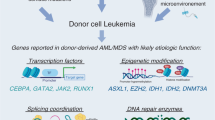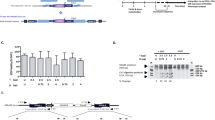Abstract
Fanconi anaemia (FA) is an autosomal recessive disorder characterized by progressive pancytopenia, short stature, radial ray defects, skin hyper-pigmentation and a predisposition to cancer1,2. Cells from FA patients are hypersensitive to cell killing and chromosome breakage induced by DNA cross-linking agents such as mitomycin C (MMC) and diepoxybutane (DEB)3,4. Consequently, the defect in FA is thought to be in DNA crosslink repair. Additional cellular phenotypes of FA include oxygen sensitivity5,6, poor cell growth7 and a G2 cell cycle delay8,9. At least 5 complementation groups for Fanconi anaemia exist, termed A through E10,11. One of the five FA genes, FA(C), has been identified by cDNA complementation12, but no other FA genes have been mapped or cloned until now. The strategy of cDNA complementation, which was successful for identifying the FA(C) gene has not yet been successful for cloning additional FA genes. The alternative approach of linkage analysis, followed by positional cloning, is hindered in FA by genetic heterogeneity and the lack of a simple assay for determining complementation groups. In contrast to genetic linkage studies, microcell mediated chromosome transfer utilizes functional complementation to identify the disease bearing chromosome13. Here we report the successful use of this technique to map the gene for the rare FA complementation group D (FA(D)).
This is a preview of subscription content, access via your institution
Access options
Subscribe to this journal
Receive 12 print issues and online access
$209.00 per year
only $17.42 per issue
Buy this article
- Purchase on Springer Link
- Instant access to full article PDF
Prices may be subject to local taxes which are calculated during checkout
Similar content being viewed by others
References
Gordon-Smith, E.C. & Rutherford, T.R. Fanconi anemia: constitutional aplastic anemia. Semin. Hematol. 28, 104–112 (1991).
Fanconi, G. Familial constitutional panmyelocytopathy, Fanconi's anemia (FA) I. Clinical aspects. Semin. Hematol. 4, 233–240 (1967).
Billardon, B. & Moustacchi, E. Comparison of the sensitivity of Fanconi's anemia and normal fibroblasts of sister-chromatic exchanges by photoaddition of mono- and bi-functional psoralens. Mutat. Res. 174, 241–246 (1986).
Cohen, M.M., Fruchtman, C.E., Simpson, S.D. & Martin, A.O. The cytogenetic response of Fanconi's anemia lymphoblastoid cell lines to various clastogens. Cytogenet. Cell Genet. 34, 230–240 (1982).
Saito, H., Hammond, A.T. & Moses, R.E. Hypersensitivity to oxygen is a uniform and secondary defect in Fanconi anemia cells. Mutat Res. 294, 255–262 (1993).
Schindler, D. & Hoehn, H. Fanconi anemia mutation causes cellular susceptibility to ambient oxygen. Am. J. hum. Genet. 43, 429–435 (1988).
Weksberg, R., Buchwald, M., Sargent, P. & Thompson-M-W, S.L. Specific cellular defects in patients with Fanconi anemia. J. Cell Physiol. 101, 311–323 (1979).
Seyschab, H., Sun, Y., Friedl, R., Schindler, D. & Hoehn, H. G2 phase cell cycle disturbance as a manifestation of genetic cell damage. Hum. Genet. 92, 61–68 (1993).
Berger, R., Le-Coniat, M. & Gendron, M.C. Fanconi anemia. Chromosome breakage and cell cycle studies. Cancer genet. Cytogenet. 68, 13–16 (1993).
Strathdee, C.A., Duncan, A.M. & Buchwald, M. Evidence for at least four Fanconi anaemia genes including FACC on chromosome 9. Nature Genet. 1, 196–198 (1992).
Joenje, H. et al. Classification of FA patients by complementation analysis: evidence for a fifth genetic subtype. Blood. In the press.
Strathdee, C.A., Gavish, H., Shannon, W.R. & Buchwald, M. Cloning of cDNAs for Fanconi's anaemia by functional complementation. Nature 358, 434 (1992).
Fournier, R.E. & Moran, R.G. Complementation mapping in microcell hybrids: localization of Fpgs and Ak-1 on Mus musculus chromosome 2. Somatic Cell Genet. 9, 69–84 (1983).
Leach, R.J., Thayer, M.J., Schafer, A.J. & Fournier, R.E. Physical mapping of human chromosome 17 using fragment-containing microcell hybrids. Genomics 5, 167–176 (1989).
Masutani, C. et al. Purification and cloning of a nucleotide excision repair complex involving the xeroderma pigmentosum group C protein and a human homologue of yeast RAD23. EMBO J. 13, 1831–1843 (1994).
Legerski, R.J. et al. Assignment of xeroderma pigmentosum group C (XPC) gene to chromosome 3p25. Genomics 21, 266–269 (1994).
Legerski, R. & Peterson, C. Expression cloning of a human DNA repair gene involved in xeroderma pigmentosum group C. Nature 369, 70–73 (1992).
Fournier, R.E. A general high-efficiency procedure for production of microcell hybrids. Proc. natn. Acad. Sci. USA 78, 6349–6353 (1981).
Mercer, W.E. & Schlegel, R.A. Phytohemagglutinin enhancement of cell fusion reduces polyethylene glycol cytotoxicity. Exp. Cell Res. 120, 417–421 (1979).
Carmichael, J., DeGraff, W.G., Gazdar, A.F. & Minna-J-D, M.J.B. Evaluation of a tetrazolium-based semiautomated colorimetric assay: assessment of chemosensitivity testing. Cancer Res. 47, 936–942 (1987).
Miller, S.A., Dykes, D.D. & Polesky, H.F. A simple salting out procedure for extracting DNA from human nucleated cells. Nucl. Acids Res. 16, 1215 (1988).
Author information
Authors and Affiliations
Rights and permissions
About this article
Cite this article
Whitney, M., Thayer, M., Reifsteck, C. et al. Microcell mediated chromosome transfer maps the Fanconi anaemia group D gene to chromosome 3p. Nat Genet 11, 341–343 (1995). https://doi.org/10.1038/ng1195-341
Received:
Accepted:
Issue Date:
DOI: https://doi.org/10.1038/ng1195-341
This article is cited by
-
First molecular-cytogenetic characterization of Fanconi anemia fragile sites in primary lymphocytes of FA-D2 patients in different stages of the disease
Molecular Cytogenetics (2016)
-
Replication of somatic micronuclei in bovine enucleated oocytes
Cell Division (2012)
-
FANCG promotes formation of a newly identified protein complex containing BRCA2, FANCD2 and XRCC3
Oncogene (2008)
-
Fanconi anemia in Tunisia: high prevalence of group A and identification of new FANCA mutations
Journal of Human Genetics (2003)
-
The emerging genetic and molecular basis of Fanconi anaemia
Nature Reviews Genetics (2001)



